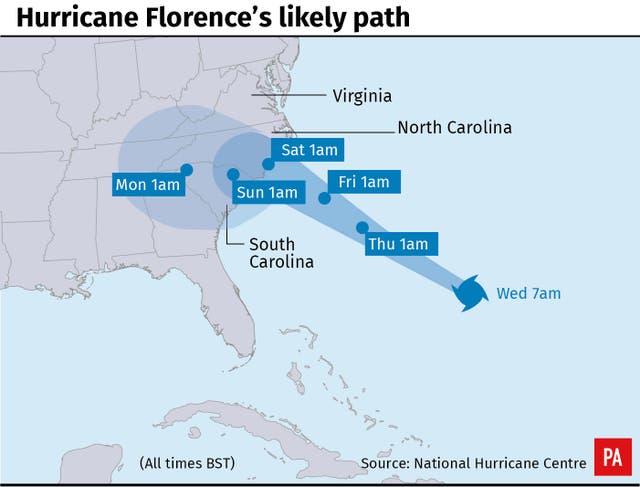
Residents along a large swathe of the US coastline have fled their homes as forecasters warned Hurricane Florence could stay just offshore for days before pushing inland.
The National Hurricane Center’s projected track has Florence hovering off the southern North Carolina coast from Thursday night until landfall on Saturday morning.
The track also shifted south and west, putting Georgia at risk as Florence moves inland.
Georgia’s governor Nathan Deal declared a state of emergency for all 159 counties and said the state “is mobilising all available resources to ensure public safety ahead of Hurricane Florence”.
The overall trend is “exceptionally bad news”, said University of Miami hurricane researcher Brian McNoldy.
As of 11am local time, the storm was centred 485 miles south east of Wilmington, North Carolina, moving at 15mph.
It is a potentially catastrophic Category 4 storm with 130mph maximum sustained winds.
Some strengthening is forecast through Wednesday night, drawing energy from the warm water. Its winds could approach Category 5 strength, which means winds of 157mph or higher.

“This is not going to be a glancing blow,” Jeff Byard, an administrator with the Federal Emergency Management Agency, warned. “This is going to be a Mike Tyson punch to the Carolina coast.”
While some said they planned to stay put despite hurricane watches and warnings extending over the homes of more than 5.4 million people on the east coast, many were not taking any chances.
Steady streams of vehicles full of people and belongings flowed inland on Tuesday as North Carolina Governor Roy Cooper tried to convince everyone on North Carolina’s coast to flee.
“The waves and the wind this storm may bring is nothing like you’ve ever seen. Even if you’ve ridden out storms before, this one is different. Don’t bet your life on riding out a monster,” he said.
WATCH: Governor Cooper stopped by the @FEMA staging location at Fort Bragg and gave an update on #HurricaneFlorence preparations. pic.twitter.com/IxS9wJ2zgz
— Governor Roy Cooper (@NC_Governor) September 11, 2018
President Donald Trump declared states of emergency for North and South Carolina and Virginia, opening the way for federal aid. He said the federal government is “absolutely, totally prepared” for Florence.
All three states ordered mass evacuations along the coast but getting out of harm’s way has proved difficult since airlines were cancelling flights and motorists had a hard time finding fuel.
Florence is the most dangerous of three tropical systems in the Atlantic. Tropical Storm Isaac was expected to pass south of Puerto Rico, Haiti, the Dominican Republic and Cuba, while Hurricane Helene was moving northward away from land.

The coastal surge from Florence could leave the eastern tip of North Carolina under more than 9ft of water in spots, projections showed.
The Navy, Air Force and Army were moving ships and aircraft out of harm’s way. Thousands of marines and their families evacuated from Camp Lejeune, leaving the rest to dig in ahead of what could be a direct hit.
Footage of #HurricaneFlorence2018 from today’s @53rdWRS @AirForceReserve Hurricane Hunter mission. pic.twitter.com/kTEm19C3CO
— Hurricane Hunters (@53rdWRS) September 11, 2018
Florence’s projected path includes half a dozen nuclear power plants, pits holding coal-ash and other industrial waste, and numerous hog farms that store animal waste in huge lagoons.
Duke Energy spokesman Ryan Mosier said operators would begin shutting down nuclear plants at least two hours before hurricane-force winds arrive.


Comments: Our rules
We want our comments to be a lively and valuable part of our community - a place where readers can debate and engage with the most important local issues. The ability to comment on our stories is a privilege, not a right, however, and that privilege may be withdrawn if it is abused or misused.
Please report any comments that break our rules.
Read the rules here